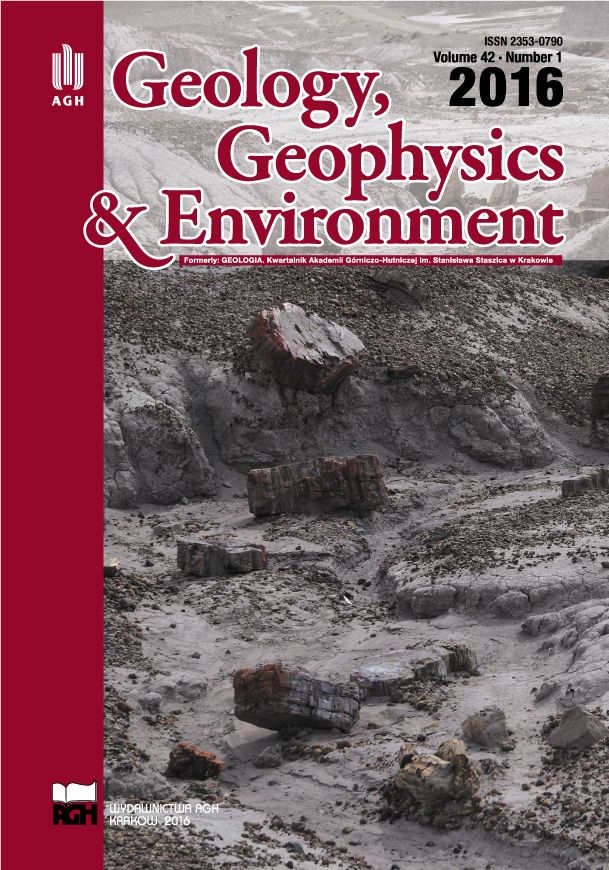The comparison of using satellite SAR and optical data in the process of urban growth monitoring.
DOI:
https://doi.org/10.7494/geol.2016.42.1.107Keywords:
SAR, Landsat, urban growth, coherent scatterersAbstract
The aim of this project was to monitor the temporal growth of the urban areas, on the example of the Krakow city (Poland). In recent years more frequent use of satellite data in environmental monitoring can be observed. Definitely the optical data are the most popular type of it. This kind of data are commonly used in many applications like land cover change detection, biomass study and in the map preparation process. Despite their many advantages they are very sensitive on the weather conditions. Thus they can not be gathered in cloudy or rainy day. This case doesn’t occur when the satellite SAR (Synthetic Aperture Radar) system are used. The ability of SAR and optical systems in monitoring the temporal growth of the urban areas were presented in the past (Opido 2015, Al Rawashdeh 2006). In these projects SAR and optical satellite systems were compered.
The presented here study were performed on fifty archival SAR and optical images acquired between years 1992 and 2010. The images were grouped into five two-year time intervals. Each interval contain data stack of eight SAR and 2 Landsat images. For each group the analysis of land cover were performed. Each optical image was classified into the three classes: water, urban and green areas. The study of SAR data were based on the analysis of coherent scatterers (Porzycka-Strzelczyk 2015). The most common used methods of coherent scatterer’s identification were tested: dispersion of amplitude, Log-Cumulant (Nicolas 204), Signal-to-cluter ratio (Ulander 2010) and coherency method (Touzi 1999).
The growth of urban area was calculated by studying changes in the number of coherent scatterers on the SAR images. For the Landsat images the changes in area of the urban class were analyzed. Furthermore, the regions of most and least intensive urban growth were detected. The next step of the project is to compare the presented results with new ESA (European Space Agency) satellites. Sentinel-1 provides SAR images with a much better spatial resolution than ERS-1, ERS-2 and Envisat satellites. Sentinel-2 has better spatial resolution and more spectral bands than Landsat-8 (Masek 2015). This will allow to achieve more precise maps of coherent scatterers.
Downloads
References
Feretti A., Prati C., Rocca F., 2001, Permanent Scatterers in SAR Interferometry, IEEE TRANSACTIONS ON GEOSCIENCE AND REMOTE SENSING, VOL. 39, NO. 1, JANUARY 2001
Masek J., 2015, HysPIRI Workshop, GSFC, https:/hyspiri.jpl.nasa.gov/downloads/2015_Symposium/day1/10_Landsat8_Sentenial2_Masek.pdf
Nicolas J.-M., Bujor F., Trouve E., 2004, Application of Log-Cumulants to the Detection of Spatiotemporal Discontinuities in Multitemporal SAR Images”, Oct 2004
Opido P., Leśniak A., 2015, Analysis of possibilities and constrains of using ERS-1, ERS-2 and Envisat radar data in the process of urban areas growth monitoring, SGEM 2015 : informatics, geoinformatics and remote sensing : 15th international multidisciplinary scientific geoconference: 18–24, June, 2015. Vol. 1, S. 973–980.
Porzycka-Srzelczyk S., Strzelczyk J., 2014, Identification of coherent scatterers in SAR images based on the analysis of polarimetric signatures, IEEE Geoscience and Remote Sensing Letters ; ISSN 1545-598X. — 2014 vol. 11 no. 4, s. 783–787
Rawashdeh S., Saleh B., 2006, Satellite Monitoring of Urban Spatial Growth in the Amman Area, Jordan, JOURNAL OF URBAN PLANNING AND DEVELOPMENT, Dec 2006
Touzi R., 1999, Coherence estimation for SAR imagery, Geoscience and Remote Sensing, IEEE Transactions on, Jan 1999
Ulander L.M.H., Barmettler A., Flood B., 2010, Signal-to-clutter ratio enhancement in bistatic very high frequency (VHF)-band SAR images of truck vehicles in forested and urban terrain, June 2010
Downloads
Published
Issue
Section
License
Authors have full copyright and property rights to their work. Their copyrights to store the work, duplicate it in printing (as well as in the form of a digital CD recording), to make it available in the digital form, on the Internet and putting into circulation multiplied copies of the work worldwide are unlimited.
The content of the journal is freely available according to the Creative Commons License Attribution 4.0 International (CC BY 4.0)










